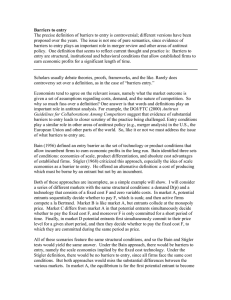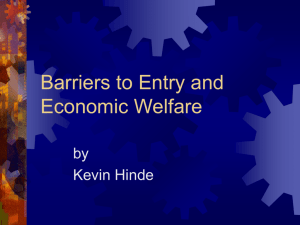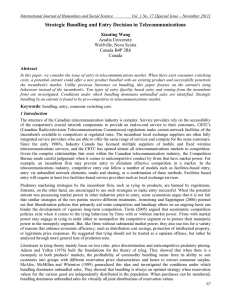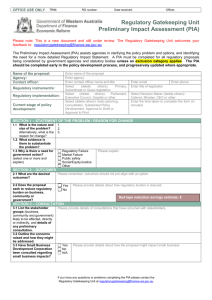Can Tying Facilitate Entry? Xiaoting Wang May 2006
advertisement
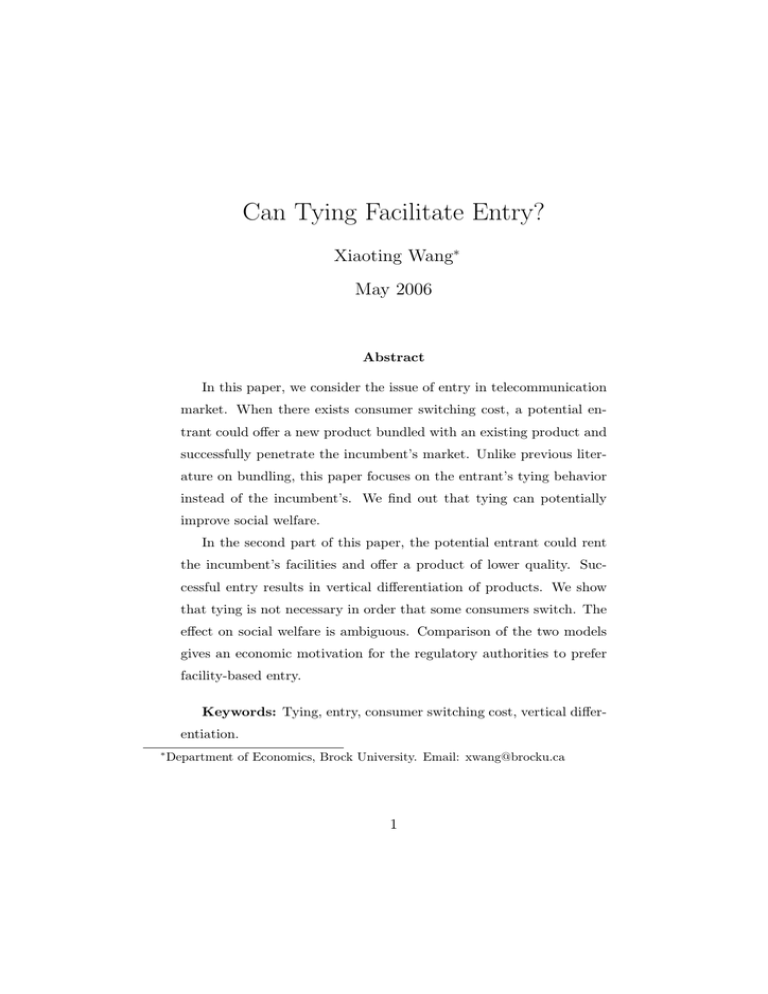
Can Tying Facilitate Entry? Xiaoting Wang∗ May 2006 Abstract In this paper, we consider the issue of entry in telecommunication market. When there exists consumer switching cost, a potential entrant could offer a new product bundled with an existing product and successfully penetrate the incumbent’s market. Unlike previous literature on bundling, this paper focuses on the entrant’s tying behavior instead of the incumbent’s. We find out that tying can potentially improve social welfare. In the second part of this paper, the potential entrant could rent the incumbent’s facilities and offer a product of lower quality. Successful entry results in vertical differentiation of products. We show that tying is not necessary in order that some consumers switch. The effect on social welfare is ambiguous. Comparison of the two models gives an economic motivation for the regulatory authorities to prefer facility-based entry. Keywords: Tying, entry, consumer switching cost, vertical differentiation. ∗ Department of Economics, Brock University. Email: xwang@brocku.ca 1 1 LITERATURE 1 2 Literature Bundling has been proved to be a successful way of predatory pricing. If a firm is the monopolist in one market, it could use the leverage provided by this power to foreclose sales in and thereby monopolize another market. Bundling can also be a way of price discrimination if consumers have heterogeneous preferences. Literatures in tying theory are vast. Adams and Yellen (1976) builds the foundations for the theory of tying. They showed that the profitability of commodity bundling stems from its ability to sort customers into groups with different reservation price characteristics and hence to extract consumer surplus. Whinston (1990) is the seminal paper in tying literature. This paper examines the consequences of tying where the market structure for the tied good is not competitive, but oligopolistic. He showed that through a precommitment to tying the monopolist reduces the sales of its tied good market competitor, thereby lowering his profits below the level that would justify continued operation. This paper also showed that with heterogeneous valuations among consumers, tying can be a profitable strategy even in the absence of precommitment. McAfee, McMillan and Whinston (1989)investigate the conditions under which bundling dominates unbundled sales. They showed that bundling is always an optimal strategy when reservation values for the various good are independently distributed in the population. When purchases can be monitored, bundling dominates unbundled sales for virtually all joint distributions of reservation values. Mathewson and Winter (1997) investigate the profitability of tying in the case that the monopolist faces uncertain demand. When two-part pricing can not extract all surplus from consumers, tying offers the monopolist additional 2 MOTIVATIONS 3 margin to extract consumer surplus. 2 Motivations Firms that have market power in one market, can use tying as a way to generate demand in and thereby successfully enter another market, when consumers evaluate highly about the tied product. Usually to induce consumers to switch from the incumbent’s product, new entrant has to offer an improved or differentiated product, otherwise it has to offer a lower price. In the latter case a price war is unavoidable. If tying is possible, the new entrant can introduce a product identical to the incumbent’s and match the incumbent’s price. Consumers who switch are compensated by the discriminatory pricing of the tied good. Bell Canada bundles its long-distance telephone service with high-speed internet service (Sympatico). In some region of Ontario Canada, Cogeco Cable was the only provider of high-speed internet services before Bell entered the market. Instead of offering a lower price, Bell offers the bundle to induce people to switch to its plan. At the same time Bell matches Cogeco’s price in high speed internet service. 3 3.1 Entry by a Homogeneous Product Setup The group of people we will focus on in this paper, are originally all firm I’s (the incumbent’s) customers in market for product A. The amount of customers are a continuum of measure 1. Consumers are differentiated in their costs switching from firm I to firm E (the potential entrant) for buying one unit of product A. Assume switching costs t are uniformly distributed on (0, t). 3 ENTRY BY A HOMOGENEOUS PRODUCT 4 Consumers have unit demand for product A. The evaluation for product A is vA (constant) for all consumers. Consumers also have unit demand for product B. The willingness to pay for product B is vB (constant) for all consumers. Denote a consumer’s utility function by V (piA , pB ) = vA − piA + vB − pB where i = I, E, or V (pAB , t) = vA + vB − pAB − t if she switches to the bundle after entry occurs. Before the entry game starts, firm I is a monopolist in the market of product A; firm E, the potential entrant into market for good A, compete with other firms in the market for product B. Suppose market for B is composed of n firms. They offer identical products with constant marginal cost c. Assume 0 < c < t. The n firms in market B compete in output levels and price is determined by inverse market demand function pB (Q). Since firms are symmetric, the market share of firm E in market B is simply 1/n. Assume that demands in the two markets are independent. So ex ante 1/n consumers from the target group purchase good B from firm E. For simplicity we assume that consumers’ switching cost in market B is negligible. If firm E does enter market A, and offers an identical product as firm I does, firm E has to pay a fixed cost F . Both firms produce A at zero marginal cost. We’ll model the entry problem in a two-stage game. Before game starts, firm I sets price for product A, pm A (monopoly’s price). At stage one, firm E, decides whether to enter market for product A. If firm E enters, it pays the fixed cost F . At stage two, if entry occurs, firm I and firm E set prices simultaneously. Firm E sets price p̃ for the bundle and pE A for the individual product A. Firm I chooses its own price pIA . After observing the prices, consumers decide whether to switch to firm E’s plan. Before moving on to the equilibrium, we will briefly review the three types 3 ENTRY BY A HOMOGENEOUS PRODUCT 5 of bundling. ”Pure component” is when products are sold individually and no bundles are offered. ”Pure bundling” is the case when products are sold only in bundles and no individual products are offered. ”Mixed bundling” is when products can be bought either in a bundle or individually. 3.2 Equilibrium Lemma 1: Pure component is a weakly dominated strategy. Proof : Since mixed bundling offers products both individually and as a bundle, mixed bundling can do at least as good as pure component. For example, if firm E uses the strategy of pure component, it offers product A and B individually at pE A and pB . However, firm E can earn as least as much by E offering product A, product B and the bundle at pE A , pB and pA + pB . This argument holds whether there is consumers’ switching cost or not. Lemma 2: When there are consumers’ switching costs, pure component is a strictly dominated strategy. Proof : Suppose that after firm E entered the market for product A, he decided to offer A as an individual product. Then firm E and firm I are offering the same product at zero marginal cost of production. Because of the existence of consumers’ switching costs, no consumer has incentive to switch to E’s product A. Therefore for firm E, offering A (only) as an individual product is strictly dominated by mixed bundling. The price competition in stage two can have various equilibrium. Instead of a description of all the equilibrium outcome, we will focus on one that is particularly interesting. As argued in Tirole (1988), firms that compete 3 ENTRY BY A HOMOGENEOUS PRODUCT 6 against each other in many markets may hesitate to fight vigorously because the prospects of local gain are not worth the risk of general warfare. The prospect of gain from vigorous competition in one market may be weighted against the loss from the retaliation by the competitor in other markets. The number of firms in the industry has been considered as affecting the possibility of collusion. The original concern with market concentration was based on an intuitive view that high concentration is necessary (if not sufficient) for collusive behavior. Proposition 1: It is a sequential equilibrium that firm I charges the monopoly m price pm A for product A; firm E charges pA for the bundle. Proof : Suppose p̂ is the current market price, or the steady-state price that firms believe. Each firm has the following conjecture: if it charges p > p̂, its rival will not match the price. If a firm cuts its price to p ≤ p̂, its rival will match its price cut. Suppose pm A maximized a monopoly’s profit in market A, then m m the optimal price for either firm is equal to p̂ if p̂ ≤ pm A and to pA if p̂ > pA . Therefore both firms charging p̂ is an equilibrium as long as p̂ lies between 0 and pm A and each firm expects its rival to react in the way described above. In particular, both firms’ charging pm A is an equilibrium. Discussion When the entrant provides product of the same quality as the incumbent’s, physical facilities need to be built, which costs a large amount of capital investment. Under the current circumstance, if the entrant charges pm A for the bundle, he is indeed offering product B for free. Consumers whose switching costs are lower than the market price for product B, will switch to firm E for a higher consumer surplus. Consumers with high switching costs will stay with the incumbent. For firm E, in order to cover the fixed cost of 3 ENTRY BY A HOMOGENEOUS PRODUCT 7 entry F and the lost profits in market B, long-run profitability of selling A has to be considerably high. when setting up this model, we ignore the possibility for firm I to enter the market for B. The CRTC (regulatory authority in telecommunications and cable television) has put strict restrictions on promotions by the incumbents , in order to enhance the competitive market structure of the industry in the future. Winter, et al.(2005) argued that promotion by the incumbents is a reflection of competition, not a deterrence to it. Here we admit that in the long run, it is possible for firm I to enter the market of B and provides bundled product. A recent advertisement from Cogeco (cable TV program provider in Ontario and Quebec), says they are now able to use cable lines to provide local telephone services. With the launching of this new technology, we could foresee Cogeco’s entry into telecommunications market by bundling this new service with its existing services. AB Corollary 1: At pIA = pE = pm A = p A , firm E’s share in market for A is s̄. A total of s̄ consumers will buy the bundle from E. Firm E sells individual product B to (1 − s̄) n1 consumers. Proof: See Appendix. Corollary 2: If both firms charge price for piA that is between 0 and pm A, all consumers will gain from the entry of firm E into the market for A. Even though both charging monopoly price for A is a sequential equilibrium, the equilibrium is not a perfect equilibrium. If the price-setting game is repeated for at least another round, both firms have incentive to undercut the rival’s price. pm A will not be stable. As long as firms start a price competition, consumers’ gain in welfare will increase. For consumers who switch, they also gain from consuming product B for free for at least one round of 4 ENTRY BY A VERTICALLY DIFFERENTIATED PRODUCT 8 the price competition between firm I and firm E. The welfare loss to the society will be the fixed cost for firm E to build its own facilities. 4 Entry by a Vertically Differentiated Product Firm E can bundle product B with an inferior product A, which has lower quality than the existing product. This is the case when the entrant rents the incumbent’s technical facilities instead of building its own, which causes net congestion. It is a legitimate assumption that the quality of the incumbent’s product A is higher than the entrant’s. 4.1 Setup Classical models of vertical differentiation, such as Shaked and Sutton (1982, 1983), is built on the assumption that consumers have different initial wealth level. Here we make the following assumption. All consumers were firm I’s customers before entry begins. Assume that they all have identical evaluation vA for one unit of high-quality A provided by the incumbent firm. Consumers differ in their switching costs t. 1 As in the previous model, assume t is uniformly distributed on (0, t̄). Assume there is no fixed cost with entry. The marginal cost for firm E is constant at c̃ in market A. Consumer Preferences For a consumer who switches to a lower-quality product A, his utility is given by 1 Switching costs here can in a way be considered as negative endowment to consumers. Instead of letting the agents be differentiated in two dimensions: initial income and switching costs. We make this assumption so that we can focus on the pure effect of switching costs. Consumers who were not firm I’s customers are not considered in this model, since switching costs in market A do not apply to them. Their behavior simply follows Shaked and Sutton (1982, 1983) when entry occurs. 4 ENTRY BY A VERTICALLY DIFFERENTIATED PRODUCT 9 E U (pE A , pB , t) = µE · (vA − t − pA ) + vB − pB For a consumer who switches to firm E’s bundle, his utility is given by U (pAB , pIA , t) = µE · (vA − t − pAB ) + vB − (pAB + t − pIA ) For a consumer who buys a bundle, the implicit price for product B is p AB + t − pIA . For a consumer who does not switch after firm E’s entry, his utility is given by U (pIA , pB ) = µI (vA − pIA ) + vB − pB µI and µE are parameters measuring the quality of product A. Assume µI = 1, and 0 < µ0 ≤ µE ≤ 1. Timing Let’s consider a two-stage game. At stage one, firm E decides whether to enter the market for A with a lower-quality product. The underlying assumption is that firm E rents from firm I for its physical facilities. At stage two, if entry occurs, firms compete in prices. Firm I sets price for A; firm E sets prices for its individual product A or the bundle, if tying is necessary. 4.2 Equilibrium We show that in the current situation, tying is not necessary for successful entry if the potential entrant introduces a product of lower quality. The 4 ENTRY BY A VERTICALLY DIFFERENTIATED PRODUCT 10 intuition behind this result here follows. In order to avoid the Bertrand equilibrium outcome, firms have to differentiate their products in some way. In the first model of this paper, the entrant offers bundled products so that product differentiation resembles the idea in Chen (1997). In the current model the entrant voluntarily chooses a product of lower quality, therefore two products A are vertically differentiated, which implies that differentiation through bundling is no longer necessary. Welfare issues are ambiguous when the entrant does not build its own physical facilities. Fixed costs can be saved. However, since promotions such as bundling are no longer necessary for successful entry, consumers who switch will not gain from such marketing strategies. In terms of longrun efficiency in the market, CRTC prefers that the new entrant builds its own physical facilities, but this will sacrifice the short-run welfare gain to consumers. 4.2.1 Entry with Bundled Products In this subsection, we assume that firm E bundles its lower-quality product A with product B. Price Competition Define tB ∈ (0, t̄), such that a consumer with switching cost tB is indifferent between staying with the incumbent’s A and switching to the entrant’s bundle at pAB , i.e. U (pIA , pB ) = U (pAB , pIA , tB ) (1) Solving the above equation, we get tB = 1 [2pIA + pB − (1 − µE )vA ] − pAB 1 + µE (2) Consumers whose switching costs are less than or equal to tB will switch to firm E’s bundle, i.e. tB is the demand for firm E in market A. Demand 4 ENTRY BY A VERTICALLY DIFFERENTIATED PRODUCT for the incumbent firm I is therefore given by t̄ − tB . 11 2 Lemma 3: Given the entrant’s choice of quality µE for product A, the Nash Equilibrium in the Price-Setting game is pIA = 1 + µE 1 − µE pB (2t̄ + c̃ + c) + vA − 6 6 6 1 pB 1 − µE pAB = [t̄ + 2c̃ + 2c − vA + ] 3 1 + µE 1 + µE when the entrant sells product A in a bundle. Proof: See Appendix. Substituting equilibrium prices into the equation for tB , we can obtain the demand function for firm E, tB = t̄ − c̃ − c pB 1 − µE − vA + 3(1 + µE ) 3(1 + µE ) 3 (3) Choice of Quality Let the entrant use “optimal reply from below” strategy in Shaked and Sutton (1982). Firm E will choose µE ∈ [µ0 , 1] to maximize (pAB − c̃ − c) · tB . First order condition is satisfied when µ∗E = vA − pB − (t̄ − c̃ − c) vA + t̄ − c̃ − c (4) In order that the profit function is concave in µE , the following inequality has to hold, 3(2vA − pB ) (5) 2(vA + t̄ − c̃ − c) If this inequality cannot hold, then maximum profit for firm E will be at µE > −1 + either µE = µ0 , or µE = 1. 2 Demand for E should be tB /t̄. Demand for I should be (t̄ − tB )/t̄. The results won’t be affected by the misuse of notations. 4 ENTRY BY A VERTICALLY DIFFERENTIATED PRODUCT pB 2 ). 2 pB + 1+µ0 12 At µE = 1, profits for firm E is (t̄ − c̃ − c + At µE = µ0 , profits for firm E is (t̄ − c̃ − c 4.2.2 − 1−µ0 v )2 . 1+µ0 A Entry without Bundling Now let us look at the case where firm E enters the market for product A without bundling with B. Price Competition Define tI ∈ (0, t̄), such that a consumer with switching cost tI is indifferent between staying with the incumbent’s A at price pIA and switching to the entrant’s individual product A at pE A , i.e. U (pIA , pB ) = U (pE A , pB , t I ) (6) Solving the above equation, we get 1 pIA E tI = (1 − )vA − pA + µE µE Consumers whose switching costs are less than or equal to tI will switch to firm E’s product A, i.e. tI is the demand for firm E in market A. Demand for the incumbent firm I is therefore given by t̄ − tI . Lemma 5: Given the entrant’s choice of quality µE for product A, the Nash Equilibrium in the price-setting game is 1 2 vA pIA = µE c̃ + µE t̄ + (1 − µE ) 3 3 3 1 2 t̄ vA + (1 − ) pE A = c̃ + 3 3 3 µE when the entrant sells individual product A. Proof: See Appendix. 5 DISCUSSION 13 Given the equilibrium prices, we can calculate demand for each firm in market for A. Demand for the entrant is 1 1 tI = [t̄ − c̃ − vA ( − 1)] 3 µE tI > 0 if µE > vA . vA +t̄−c̃ Choice of quality Let firm E choose an optimal quality µE ∈ [µ0 , 1] that maximizes its profit tI (pE A − c̃). First order condition is satisfied when µE = vA vA + t̄ − c̃ The profit function is concave in µE when µE > vA 3 · 2 vA + t̄ − c̃ So maximum profit will occur at one of the boundaries, either at µE = µ0 , or at µE = 1. 5 Discussion 5 DISCUSSION 14 Appendix Proof of Lemma 3: Assume firm E’s profits in market B are negligible. (pB does not have to be negligible, and it is exogenous in this paper.) Firm E chooses pAB to maximize tB · (pAB − c − c̃). First order condition is sufficient for the maximum, c̃ + c − 2pAB + 1 [2pI + pB − (1 − µE )vA ] = 0 1 + µE A (7) Firm I chooses pIA to maximize (t̄ − tB ) · pIA . First order condition is sufficient for the maximum, − 4 1 1 − µE pIA + t̄ + pAB − pB + vA = 0 1 + µE 1 + µE 1 + µE (8) Solving for pAB and pIA simultaneously, we get the following equilibrium prices: pIA = 1 + µE 1 − µE pB (c + c̃ + 2t̄) + vA − 6 6 6 1 − µE pB 1 vA + ] pAB = [t̄ + 2c̃ + 2c − 3 1 + µE 1 + µE Proof of Lemma 5: E Firm E chooses pE A to maximize its profit tI ·(pA −c̃). First order condition is sufficient for the maximum, 2pE A = (1 − 1 1 I )vA + c̃ + p µE µE A (9) Firm I chooses pIA to maximize its profit (t̄−tI )·pIA . First order condition is sufficient for the maximum, 5 DISCUSSION 15 2 I 1 pA = t̄ − (1 − )vA + pE A µE µE (10) Equilibrium prices are obtained by solving these two first order conditions jointly. REFERENCES 16 References [1] Bergin, J. (2005), Microeconomic Theory, Oxford University Press. [2] Chen, Y. (1997), “Equlibrium Product Bundling,” Journal of Business, 70(1), 85-103. [3] Iacobucci, E., Trebilcock, M., and Winter, R.A. (2005), “The Canadian Experience with Deregulation,” Working Paper, University of Toronto. [4] McAfee, R.P., McMillan J., and Whinston, M. (1989), “Multiproduct Monopoly, Commodity Bundling, and Correlation of Values,” Quarterly Journal of Economics, 104, 371-384. [5] Nalebuff, B. (2004), “Bundling as an Entry Barrier,” Quarterly Journal of Economics, February 2004, 159-187. [6] Shaked, A., and Sutton, J. (1982), “Relaxing Price Competition Through Product Differentiation,” Review of Economic Studies, 49, 314. [7] Shaked, A., and Sutton, J. (1983), “Natural Oligopolies,” Econometrica, 51(5), 1469-1483. [8] Tirole, Jean. (1988), Theory of Industrial Organization, MIT Press. [9] Wang, R. and Wen, Q. (1998), “Strategic Invasion in Markets with Switching Costs,” Journal of Economics and Management Strategy, 7(4), 521-549. [10] Whinston, M.D. (1990), “Tying, Foreclosure and Exclusion,” American Economic Review, 80(4), 837-859.


